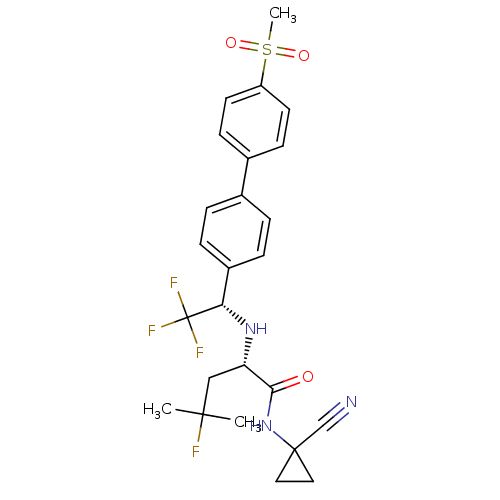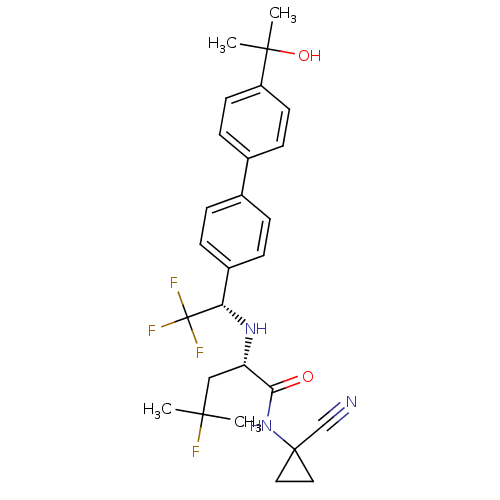TargetCathepsin K(Homo sapiens (Human))
Merck Frosst Centre For Therapeutic Research
Curated by ChEMBL
Merck Frosst Centre For Therapeutic Research
Curated by ChEMBL
Affinity DataIC50: 0.200nMAssay Description:Inhibition of humanized rabbit cathepsin KMore data for this Ligand-Target Pair
TargetCathepsin K(Homo sapiens (Human))
Merck Frosst Centre For Therapeutic Research
Curated by ChEMBL
Merck Frosst Centre For Therapeutic Research
Curated by ChEMBL
Affinity DataIC50: 0.200nMAssay Description:Inhibition of humanized rabbit cathepsin KMore data for this Ligand-Target Pair
TargetCathepsin K(Homo sapiens (Human))
Merck Frosst Centre For Therapeutic Research
Curated by ChEMBL
Merck Frosst Centre For Therapeutic Research
Curated by ChEMBL
Affinity DataIC50: 0.200nMAssay Description:Inhibition of humanized rabbit cathepsin KMore data for this Ligand-Target Pair
TargetCathepsin K(Homo sapiens (Human))
Merck Frosst Centre For Therapeutic Research
Curated by ChEMBL
Merck Frosst Centre For Therapeutic Research
Curated by ChEMBL
Affinity DataIC50: 0.200nMAssay Description:Inhibition of humanized rabbit cathepsin KMore data for this Ligand-Target Pair
TargetCathepsin K(Homo sapiens (Human))
Merck Frosst Centre For Therapeutic Research
Curated by ChEMBL
Merck Frosst Centre For Therapeutic Research
Curated by ChEMBL
Affinity DataIC50: 0.200nMAssay Description:Inhibition of humanized rabbit cathepsin KMore data for this Ligand-Target Pair
TargetCathepsin K(Homo sapiens (Human))
Merck Frosst Centre For Therapeutic Research
Curated by ChEMBL
Merck Frosst Centre For Therapeutic Research
Curated by ChEMBL
Affinity DataIC50: 0.300nMAssay Description:Inhibition of humanized rabbit cathepsin KMore data for this Ligand-Target Pair
TargetCathepsin K(Homo sapiens (Human))
Merck Frosst Centre For Therapeutic Research
Curated by ChEMBL
Merck Frosst Centre For Therapeutic Research
Curated by ChEMBL
Affinity DataIC50: 0.300nMAssay Description:Inhibition of humanized rabbit cathepsin KMore data for this Ligand-Target Pair
TargetCathepsin K(Homo sapiens (Human))
Merck Frosst Centre For Therapeutic Research
Curated by ChEMBL
Merck Frosst Centre For Therapeutic Research
Curated by ChEMBL
Affinity DataIC50: 0.400nMAssay Description:Inhibition of humanized rabbit cathepsin KMore data for this Ligand-Target Pair
TargetCathepsin K(Homo sapiens (Human))
Merck Frosst Centre For Therapeutic Research
Curated by ChEMBL
Merck Frosst Centre For Therapeutic Research
Curated by ChEMBL
Affinity DataIC50: 0.400nMAssay Description:Inhibition of humanized rabbit cathepsin KMore data for this Ligand-Target Pair
TargetCathepsin K(Homo sapiens (Human))
Merck Frosst Centre For Therapeutic Research
Curated by ChEMBL
Merck Frosst Centre For Therapeutic Research
Curated by ChEMBL
Affinity DataIC50: 0.400nMAssay Description:Inhibition of humanized rabbit cathepsin KMore data for this Ligand-Target Pair
TargetCathepsin K(Homo sapiens (Human))
Merck Frosst Centre For Therapeutic Research
Curated by ChEMBL
Merck Frosst Centre For Therapeutic Research
Curated by ChEMBL
Affinity DataIC50: 0.5nMAssay Description:Inhibition of humanized rabbit cathepsin KMore data for this Ligand-Target Pair
TargetCathepsin K(Homo sapiens (Human))
Merck Frosst Centre For Therapeutic Research
Curated by ChEMBL
Merck Frosst Centre For Therapeutic Research
Curated by ChEMBL
Affinity DataIC50: 2.60nMAssay Description:Inhibition of humanized rabbit cathepsin KMore data for this Ligand-Target Pair












